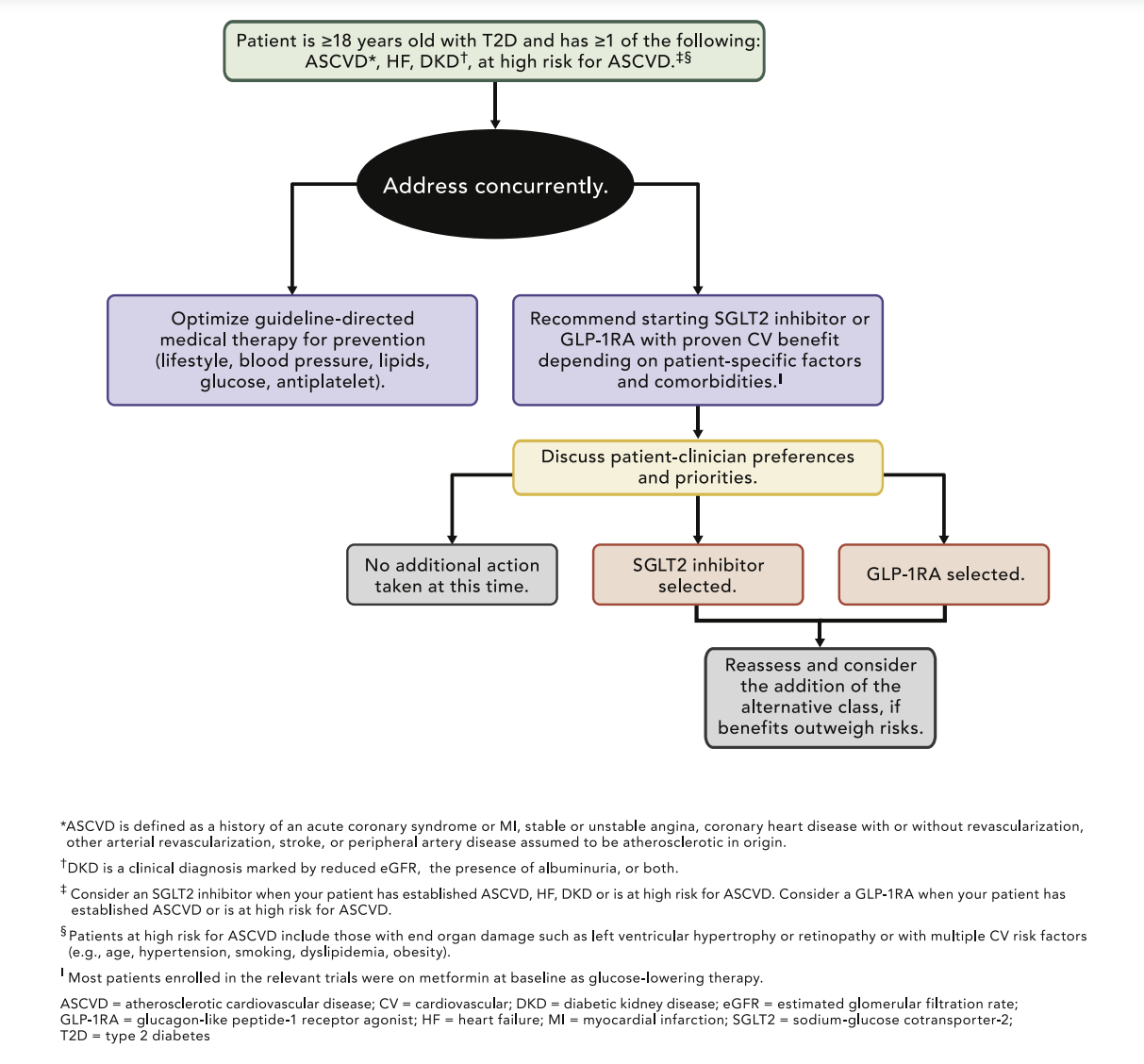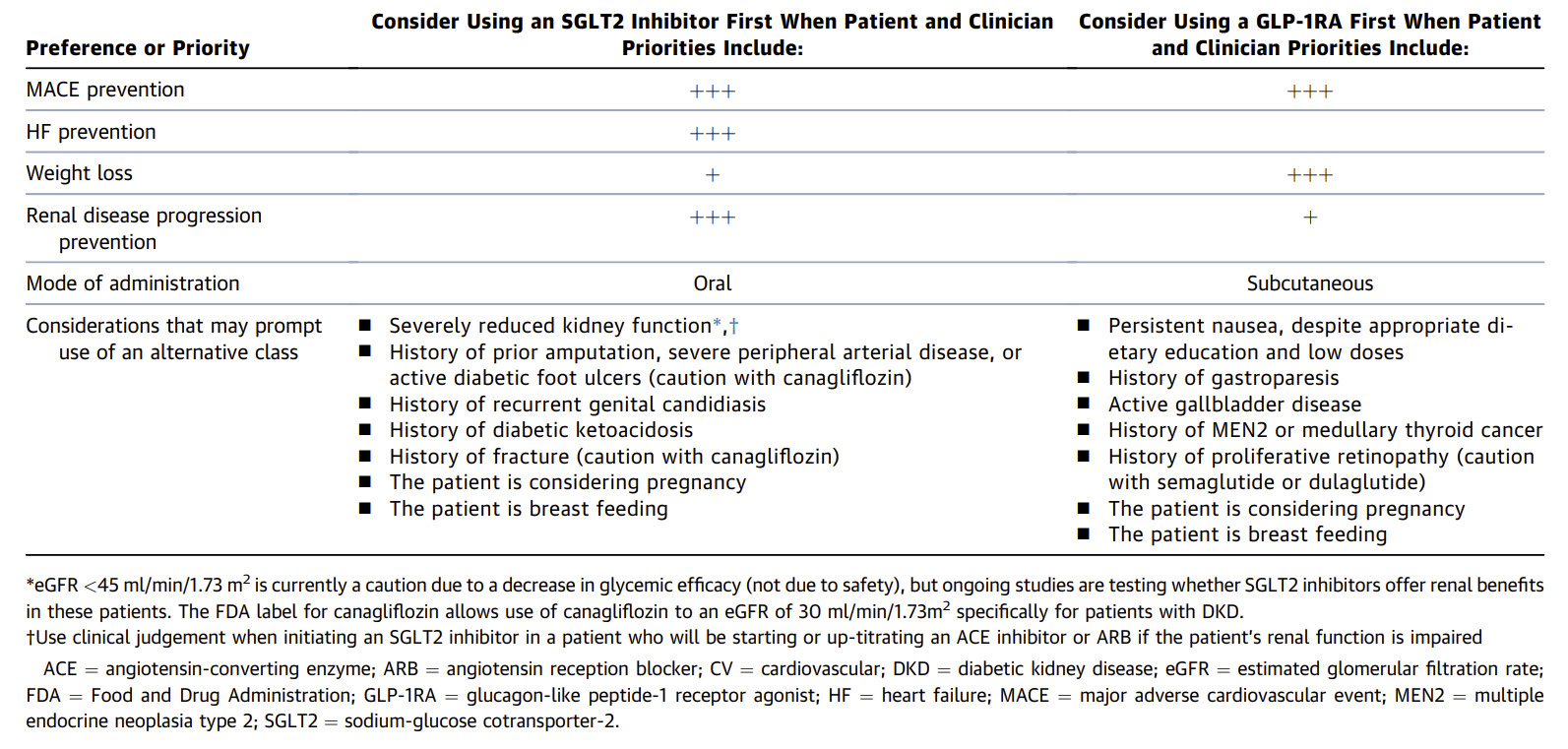The Evolving Role of Newer Glucose Lowering Therapies in Improving Cardiovascular and Renal Outcomes: from the ACC Expert Consensus Decision Pathway
Quick Takes
- Specific SGLT2 inhibitors (empagliflozin, canagliflozin, dapagliflozin) improve HF, kidney, and ASCVD outcomes.
- Inpatients with established ASCVD or at high risk for ASCVD, selected GLP-1RA (liraglutide, dulaglutide, injectable semaglutide) to reduce ASCVD events.
- Cardiologists should actively look to prescribe these medications when clinically indicated to achieve the best possible patient outcomes.
Introduction
Diabetes is a pernicious disease which, among other things, increases patients' risks of heart attack, stroke, and death.1 In fact, cardiovascular (CV) disease is the leading cause of morbidity and mortality in patients with type 2 diabetes mellitus (T2D), the most common form of diabetes seen in a cardiology practice.2 Despite this, for decades we had no diabetes-specific drugs proven to reduce CV events. Instead, we advocated strongly for lifestyle changes, such as exercise and maintaining a healthy weight, and CV risk factor modification, such as blood pressure and lipid control, as a means to improve our patients' CV outcomes.3
However, the landscape of managing patients with diabetes has shifted dramatically in just the past few years, with the emergence of sodium-glucose cotransporter-2 (SGLT2) inhibitors and glucagon-like peptide-1 receptor agonists (GLP-1RA). Specific drugs in these classes are the first glucose-lowering therapies demonstrated to improve CV outcomes in large randomized trials. Recognizing that our approach as cardiologists to treating patients with T2D had to incorporate these newly proven therapies, the American College of Cardiology (ACC) developed the 2018 ACC Expert Consensus Decision Pathway on Novel Therapies for Cardiovascular Risk Reduction in Patients With Type 2 Diabetes and Atherosclerotic Cardiovascular Disease.4 This document was intended as a practical guide to these drugs for the CV specialist and incorporated input from a multidisciplinary array of clinical care providers and stakeholders, including the American Diabetes Association.
Key changes in the updated 2020 version of the Expert Consensus Decision Pathway (ECDP)5 included expanding the recommended role of SGLT2 inhibitors in heart failure (HF)6 and diabetic kidney disease (DKD)7 as well as adding to the list of GLP-1RA with demonstrated CV benefit (Figure 1).8 Based on evidence from large CV outcomes trials, the 2018 ECDP recommended cardiologists consider initiating an SGLT2 inhibitor9-11 and/or a GLP-1RA8,12,13 with demonstrated CV benefit for their patients with T2D and established atherosclerotic CV disease (ASCVD).
Figure 1
In the two short years after those recommendations were published, more outcomes trials were reported, solidifying the role of these new agents, and in the case of SGLT2 inhibitors, broadening their indications substantially, leading the ACC to update its recommendations as the 2020 Expert Consensus Decision Pathway on Novel Therapies for Cardiovascular Risk Reduction in Patients With Type 2 Diabetes. The 2020 ECDP called for consideration of specific, trial-proven agents in patients at high risk for developing ASCVD, those with DKD, those at high risk of developing HF, and those with established HF with reduced ejection fraction (HFrEF). Since the 2020 ECDP came out, two more trials have been reported for SGLT2 inhibitors, confirming the previously demonstrated improvement in HFrEF outcomes in patients both with and without T2D,14 and for the first time expanding their benefit with regard to kidney outcomes to patients without T2D.15 These drugs have now become primarily CV and kidney disease drugs that incidentally can help lower glucose.
Atherosclerotic Cardiovascular Disease
The 2018 ECDP called for use of these newer agents in patients with T2D and ASCVD. Since then, the REWIND trial8 demonstrated benefit of the GLP-1RA, dulaglutide, at reducing adverse CV events in patients at high risk of ASCVD, compared with placebo. Thus, dulaglutide8 joins liraglutide12 and injectable semaglutide13 for that Food and Drug Administration (FDA) indicated use — although only liraglutide has shown a statistically significant reduction in CV death and earned that additional FDA indication. An oral formulation of semaglutide has been studied in the PIONEER-6 trial,16 which showed a non-significant reduction in adverse CV events on par with that seen for injectable semaglutide, although PIONEER-6 was not powered to demonstrate superiority at that effect size and further data are needed.
A recent meta-analysis17 of large randomized controlled trials of empagliflozin,9 canagliflozin,7,10 dapagliflozin,11 and ertugliflozin18 assessed the effect of SGLT2 inhibitors on ASCVD, HF, and kidney outcomes. That study showed heterogeneity in the drugs' effect on major adverse CV events (MACE) with a pooled estimate favoring modest benefit. In fact, ertugliflozin, the most recently studied drug in this class, did not demonstrate any significant ASCVD benefit.18 Although this could be due to differences in the populations studied, or even chance, the data so far raise a concern for clinically relevant intraclass heterogeneity regarding an ASCVD benefit, and further research exploring this is warranted. In contrast, all four studied SGLT2 inhibitors had large and consistent benefits across the class with regard to HF and kidney outcomes.
Chronic Kidney Disease
The SGLT2 inhibitor canagliflozin was the first SGLT2 inhibitor trial to consider kidney disease progression as a primary endpoint in patients with DKD.7 The positive results of that trial led to its incorporation into the 2020 ECDP algorithm. Subsequently, a chronic kidney disease (CKD) progression trial of dapagliflozin in patients with and without T2D has been reported (DAPA-CKD15). Approximately one third of patients in DAPA-CKD did not have T2D, and the study showed similar benefit regardless of prevalent T2D. Secondary outcomes analyses of empagliflozin and ertugliflozin are concordant. Taken together, these trials demonstrate that SGLT2 inhibitors are likely to have an important role in the management of CKD moving forward, although it is important to note that patients with CKD 5 or end-stage kidney disease (ESKD) were excluded from these trials. GLP-1RA have shown a reduction in albuminuria progression, a generally softer surrogate kidney endpoint. Thus, it seems less likely GLP-1RA would be used primarily for their renal effects.
Heart Failure
Dapagliflozin (DAPA-HF6) created shock waves through the HF community by showing a reduction in death or HF hospitalization versus placebo in a large trial of HFrEF patients, more than half of whom did not have T2D. This led to consideration of dapagliflozin for HF prevention and treatment to be strongly advocated for by the 2020 ECDP. Since then, empagliflozin14 has also shown a marked reduction in HF hospitalization or death in patients with HFrEF with or without T2D. It seems likely these large, well-done CV outcomes trials will result in rapid incorporation of SGLT2 inhibitors into the HF guidelines.
Other Considerations
The 2020 ECDP5 identifies the specific drugs within each class have been demonstrated to prevent major cardiovascular and kidney events and provides greater detail; other relevant considerations will likely impact choice of drug class (Table 1). Neither SGLT2 inhibitors nor GLP-1RA have been studied in women who are pregnant or breast feeding. SGLT2 inhibitors have not been studied in ESRD; in contrast, selected GLP-1RA can be used in ESRD. GLP-1RA are effective in a dose dependent manner at glucose lowering and weight loss. The glucose lowering and weight loss effects of SGLT2 inhibitors are more modest in comparison. In patients taking insulin or insulin secretagogues, addition of GLP-1RA and SGLT2 inhibitors can lead to hypoglycemia and glucose should be followed more closely after their initiation.
Table 1
To minimize the risk of ketoacidosis in the absence of marked hyperglycemia, sometimes called "euglycemic DKA", caution patients not to take SGLT2 inhibitors if they are not eating, including for 3 days before a procedure requiring food abstinence. Genital fungal infections are the most seen SGLT2 inhibitor adverse effect; patients should be advised to pay close attention to urogenital hygiene. The diuretic effect of SGLT2 inhibitors can require loop diuretic dose adjustment and it remains prudent to use caution in prescribing these drugs in patients with known or suspected severe lower extremity peripheral vascular disease. GLP-1RA slow gastric emptying and can cause nausea and vomiting. This can be mitigated by encouraging smaller meal portions, however GLP-1RA are often poorly tolerated in patients with pre-existing gastroparesis or prior gastric surgery.
| KEY POINTS |
|
References
- Statistics About Diabetes (American Diabetes Association website). 2020. Available at: https://www.diabetes.org/resources/statistics/statistics-about-diabetes . Accessed 10/22/2020.
- Rawshani A, Rawshani A, Gudbjornsdottir S. Mortality and cardiovascular disease in type 1 and type 2 diabetes. N Engl J Med 2017;377:300-301.
- Introduction: Standards of Medical Care in Diabetes-2020. Diabetes Care 2020;43:S1-S2.
- Das SR, Everett BM, Birtcher KK, et al. 2018 ACC expert consensus decision pathway on novel therapies for cardiovascular risk reduction in patients with type 2 diabetes and atherosclerotic cardiovascular disease: a report of the American College of Cardiology Task Force on Expert Consensus Decision Pathways. J Am Coll Cardiol 2018;72:3200–23.
- Das SR, Everett BM, Birtcher KK, et al. 2020 Expert consensus decision pathway on novel therapies for cardiovascular risk reduction in patients with type 2 diabetes: a report of the American College of Cardiology Solution Set Oversight Committee. J Am Coll Cardiol 2020;Oct 9:[Epub ahead of print].
- McMurray JJV, Solomon SD, Inzucchi SE, et al. Dapagliflozin in patients with heart failure and reduced ejection fraction. N Engl J Med 2019;381:1995-2008.
- Perkovic V, Jardine MJ, Neal B, et al. Canagliflozin and renal outcomes in type 2 diabetes and nephropathy. N Engl J Med 2019;380:2295-2306.
- Gerstein HC, Colhoun HM, Dagenais GR, et al. Dulaglutide and cardiovascular outcomes in type 2 diabetes (REWIND): a double-blind, randomized placebo-controlled trial. Lancet 2019;394:121-130.
- Zinman B, Wanner C, Lachin JM, et al. Empagliflozin, cardiovascular outcomes, and mortality in type 2 diabetes. N Engl J Med 2015;373:2117-28.
- Neal B, Perkovic V, Mahaffey KW, et al. Canagliflozin and cardiovascular and renal events in type 2 diabetes. N Engl J Med 2017;377:644-57.
- Wiviott SD, Raz I, Bonaca MP, et al. Dapagliflozin and cardiovascular outcomes in type 2 diabetes. N Engl J Med 2019;380:347-57.
- Marso SP, Daniels GH, Brown-Frandsen K, et al. Liraglutide and cardiovascular outcomes in type 2 diabetes. N Engl J Med 2016;375:311-22.
- Marso SP, Bain SC, Consoli A, et al. Semaglutide and cardiovascular outcomes in patients with type 2 diabetes. N Engl J Med 2016;375:1834-44.
- Packer M, Anker SD, Butler J, et al. Cardiovascular and renal outcomes with empagliflozin in heart failure. N Engl J Med 2020;383:1413-24.
- Heerspink HJL, Stefansson BV, Correa-Rotter R, et al. Dapagliflozin in patients with chronic kidney disease. N Engl J Med 2020;383:1436-46.
- Husain M, Birkenfeld AL, Donsmark M, et al. Oral semaglutide and cardiovascular outcomes in patients with type 2 diabetes. N Engl J Med 2019;381:841-851.
- McGuire DK, Shih WJ, Cosentino F, et al. Association of SGLT2 inhibitors with cardiovascular and kidney outcomes in patients with type 2 diabetes: a meta-analysis. JAMA Cardiol 2020;Oct 7:[Epub ahead of print].
- Cannon CP, Pratley R, Dagogo-Jack S, et al. Cardiovascular outcomes with ertugliflozin in type 2 diabetes. N Engl J Med 2020;383:1425-35.
Clinical Topics: Diabetes and Cardiometabolic Disease, Dyslipidemia, Lipid Metabolism
Keywords: Sodium-Glucose Transporter 2, Sodium Potassium Chloride Symporter Inhibitors, Cardiovascular Diseases, Diabetes Mellitus, Type 2, Albuminuria, Glucagon-Like Peptide 1, Metabolic Syndrome
< Back to Listings


